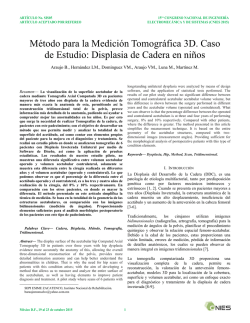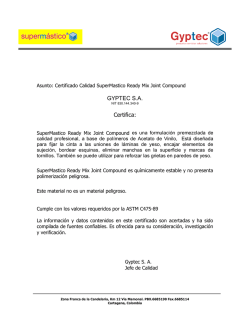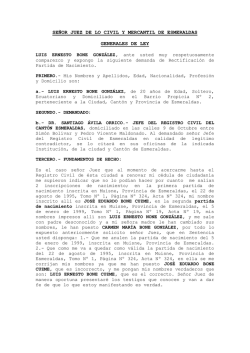
Zona pdf free
Fractura de acetábulo en ancianos: Artroplastia total de cadera en agudo Dr. Gerardo Zanotti Hospital Italiano de Buenos Aires Se presenta el caso de un paciente de 82 años de edad, de sexo masculino, que ingresó por Guardia con diagnóstico de fractura de acetábulo izquierdo. Figura 1. Radiografías al ingreso. Figura 2. Tomografía axial computarizada al ingreso. 1. Según los estudios antes evaluados, ¿qué estructuras anatómicas del acetábulo están comprometidas por la fractura? OPCIÓN CORRECTA: B a) Compromiso de la columna posterior y anterior, luxación central de la cabeza femoral, sin compromiso del techo. b) Compromiso de la columna anterior, tercio anterior del techo con impactación articular y fondo acetabular, lo que produjo una luxación central de la cabeza femoral. c) Compromiso de la columna posterior y del techo, sin luxación de la cabeza femoral. d) Compromiso de la columna posterior, fondo acetabular, luxación central de la cabeza femoral, sin compromiso del techo acetabular. 2. En función de las características del paciente y las de la fractura: ¿cuál es el tratamiento de elección? OPCIÓN CORRECTA: C a) Reducción y osteosíntesis con placa y tornillos. b) Tracción de esquelética por 45 días y, luego, movilidad progresiva hasta lograr deambulación con carga total a los 3 meses. c) Artroplastia total de cadera con copa de metal trabecular no cementada, más injertos autólogos más injerto de Banco y tallo cementado. d) Artroplastia total de cadera con copa cementada sin injertos y tallo cementado de revisión. Por las condiciones clínicas del paciente, la impactación de la carilla articular y la calidad ósea, se decidió realizar una reconstrucción con una artroplastia total de cadera híbrida en agudo. La reconstrucción acetabular se llevó a cabo con técnica de injertos óseos impactados utilizando la cabeza femoral del paciente complementado con hueso cadavérico de Banco. Se colocó copa de metal trabecular Tantalio (Zimmer, Warsaw, Indiana), tamaño 64, fijada por 4 tornillos de 6,5 mm (2 de 40 mm, 1 de 35 mm y 1 de 25 mm), todos colocados en hueso del paciente y con buen amarre. Uno de los tornillos se colocó realizando un orificio en el metal trabecular con una mecha rápida buscando un amarre firme. En su interior, se cementó una copa de polietileno de alto entrecruzamiento ZCA (Zimmer, Warsaw, Indiana), tamaño 59, con un diámetro interno de 32 mm. Luego, se cementó un tallo bicónico, pulido espejo CPT (Zimmer, Warsaw, Indiana), tamaño 5, lateralizado y cabeza de 32 mm de diámetro y + 0 de longitud (Figura 3). Figura 3. Radiografías posoperatorias inmediatas. Figura 4. Radiografías a los 3 meses de la cirugía. Se observa incorporación de los injertos óseos, sin migración del componente acetabular. Figura 5. Paciente a los 3 meses de la cirugía. Marcha con bastón con carga total. Figura 6. Control radiográfico a los 2 años posoperatorios. Bibliografía 1. Matta JM, Anderson LM, Epstein HC. Fractures of the acetabulum. A retrospective analysis. Clin Orthop Relat Res 1986;205:230-250. 2. Matta JM, Merritt PO. Displaced acetabular fractures. Clin Orthop Relat Res 1986;230:83-97. 3. Tornetta P. Displaced acetabular fractures: indications for operative and nonoperative management. J Am Acad Orthop Surg 2001;9:18-28. 4. Matta JM. Fractures of the acetabulum: accuracy of reduction and clinical results of patients managed operatively within three weeks after the injury. J Bone Joint Surg Am 1996;78:1632-1645. 5. Judet R, Letournel E. Fractures of the acetabulum: classification and surgical approaches for open reduction. J Bone Joint Surg Am 1964;46:1615-1646. 6. Oransky M, Sanquinetti C. Surgical treatment of displaced acetabular fractures. Clin Orthop Relat Res 1989;246:57-64. 7. Ruesch PD, Holdener H, Ciaramitaro M, et al. A prospective study of operatively treated acetabular fractures. Clin Orthop Relat Res 1994;305:3846. 8. Rommes DW, Lewallen D. Total hip arthroplasty after fracture of the acetabulum. Long-terms results. J Bone Joint Surg Br 1990;72:761-764. 9. Bellabarba C, Berger RA, Bentley CD, et al. Cementless acetabular reconstruction after acetabular fracture. J Bone Joint Surg Am 1998;80:1295-1305. 10. Weber M, Berry DJ, Harmsen WS. Total hip arthroplasty after operative treatment of an acetabular fracture. J Bone Joint Surg Am 1998;72:761-764. 11. Helfet DL, Borrelli J, DiPasquale T, et al. Stabilization of acetabular fractures in elderly patients. J Bone Joint Surg Am 1992;74:753-765. 12. Moed BR, McMichael JC. Outcomes of posterior wall fractures of the acetabulum. J Bone Joint Surg Am 2007;89:1170-1176. 13. Liebergall M, Mosheiff R, Low J, et al. Acetabular fractures. Clinical outcome of surgical treatment. Clin Orthop Relat Res 1999;336:205-216. 14. Mears DC, Velyvis JH. Acute total hip arthroplasty for selected displaced acetabular fractures. Two to twelve year results. J Bone Joint Surg Am 2002;84:1-9. 15. Kreder HJ, Rozen N, Borkhoff CM, et al. Determinants of functional outcome after simple and complex acetabular fractures involving the posterior wall. J Bone Joint Surg Br 2006;88:776-782. 16. Mears DC. Surgical treatment of acetabular fractures in elderly patients with osteoporotic bone. J Am Acad Orthop Surg 1999;7:128-141. 17. Spencer RF. Acetabular fractures in older patients. J Bone Joint Surg Br 1989;71:774-776. 18. Carroll EA, Huber FG, Goldman AT, Virkus WW, Pagenkopf, Lorich DG, Helfet DL. Treatment of acetabular fractures in an older population. J Orthop Trauma 2010;24:637-644. 19. Gross AE, Goodman SB. Rebuilding the skeleton: the intraoperative use of trabecular metal in revision total hip arthroplasty. J Arthroplasty 2005;20(4 Suppl 2):91. 20. Sporer SM, Paprosky WG. The use of a trabecular metal acetabular component and trabecular metal augment for severe acetabular defects. J Arthroplasty 2006;21(6 Suppl 2):83. 21. Sporer SM, Paprosky WG. Acetabular revision using a trabecular metal acetabular component for severe acetabular bone loss associated with a pelvic discontinuity. J Arthroplasty 2006;21(6 Suppl 2):87. 22. Unger AS, Lewis RJ, Gruen T. Evaluation of a porous tantalum uncemented acetabular cup in revision total hip arthroplasty: clinical and radiological results of 60 hips. J Arthroplasty 2005;20:1002. 23. Weeden SH, Schmidt RH. The use of tantalum porous metal implants for Paprosky 3A and 3B defects. J Arthroplasty 2007;22(6 Suppl 2):151. 24. Levine B, la Valle CJ, Jacobs JJ. Applications of porous tantalum in total hip arthroplasty. J Am Acad Orthop Surg 2006;14:646. 25. Berger RA, Jacobs JJ, Quigley LR, et al. Primary cementless acetabular reconstruction in patients younger than 50 years old. 7- to 11-year results. Clin Orthop Relat Res 1997;344:216-226. 26. Berry DJ, Halasy M. Uncemented acetabular components for arthritis after acetabular fracture. Clin Orthop Relat Res 2002;405:164-167. 27. Rogan I, Weber FA, Solomon L. Total hip replacement following fracture dislocation of the acetabulum. J Bone Joint Surg Br 1979;61:252. 28. Romness DW, Lewallen DG. Total hip arthroplasty after fracture of the acetabulum. Long-term results. J Bone Joint Surg Br 1990;72:761-764. 29. Berry DJ. Total hip arthroplasty following acetabular fracture. Orthopedics 1999;22:837-839. 30. Matta JM, Ferguson TA. Total hip replacement after acetabular fracture. Orthopedics 2005;28(9):959.
© Copyright 2026


